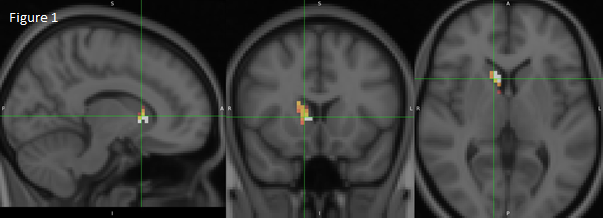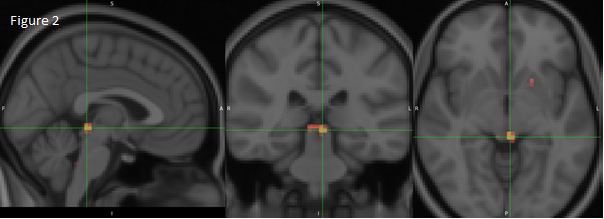Category: Dystonia: Pathophysiology, Imaging
Objective: Our aim is to investigate whether altered cholinergic function is associated with isolated adult-onset cervical dystonia (CD).
Background: Animal models and clinical observations suggest that cholinergic signaling plays a crucial role in dystonia pathophysiology1. Utilizing PET imaging with [18F]VAT as a surrogate for cholinergic neurons offers a unique opportunity to explore biochemical mechanisms in human dystonia. We hypothesize that individuals with adult-onset isolated CD will exhibit aberrant striatal cholinergic neuron measures.
Method: Dynamic PET images were acquired immediately post-administration of [18F]VAT in twenty CD patients and age- and gender-matched controls. We segmented caudate and putamen based on T1 MPRAGE images obtained in temporal proximity to PET scan using FreeSurfer 7.3 and manual edits. Standardized Uptake Value Ratio (SUVR) was computed using an eroded white matter reference region2, followed by group-level comparison using FSL randomize to apply a threshold-free cluster enhancement to perform a t-test comparing [18F]VAT uptake between groups.
Results: Preliminary analysis reveals foci of reduced [18F]VAT uptake in the right caudate, superior colliculus, and left putamen in CD compared to healthy controls.
Conclusion: These preliminary findings suggest reduced cholinergic markers in CD patients compared to healthy controls in brain regions previously implicated in dystonia. This has implications for understanding the pathophysiological mechanisms of isolated dystonia and warrants further study to validate these results and explore potential variations across focal dystonia subtypes and in relation to clinical characteristics.
Reduced uptake in right caudate in CD population.
Reduced uptake in sup. colliculus and L putamen.
References: 1. Eskow Jaunarajs KL, Bonsi P, Chesselet MF, Standaert DG, Pisani A. Striatal cholinergic dysfunction as a unifying theme in the pathophysiology of dystonia. Prog Neurobiol. 2015;127-128:91-107. doi: 10.1016/j.pneurobio.2015.02.002. PubMed PMID: 25697043; PMCID: PMC4420693.
2. O’Donnell J, Soda AK, Norris SA, Maiti B, Campbell MC, Tu Z, Perlmutter JS. PET Quantification of [18F]VAT in Human Brain and its Test-Retest Reproducibility and Age Dependence, Journal of Nuclear Medicine, (accepted 3/2024).
3. McGovern, et al, Disrupted Superior Collicular Activity may Reveal Cervical Dystonia Disease Pathomechanasims. Sci Rep. 2017;7(1) doi: 10.1038/s41598-017-17074-x. PMID: 29196716, PMCID: PMC5711841
To cite this abstract in AMA style:
N. Goldman, J. O'Donnell, A. Tanenbaum, J. Lee, J. Perlmutter, S. Norris. Altered [18F]VAT Uptake Supports Cholinergic Dysfunction in Isolated Adult-Onset Cervical Dystonia [abstract]. Mov Disord. 2024; 39 (suppl 1). https://www.mdsabstracts.org/abstract/altered-18fvat-uptake-supports-cholinergic-dysfunction-in-isolated-adult-onset-cervical-dystonia/. Accessed December 19, 2025.« Back to 2024 International Congress
MDS Abstracts - https://www.mdsabstracts.org/abstract/altered-18fvat-uptake-supports-cholinergic-dysfunction-in-isolated-adult-onset-cervical-dystonia/


